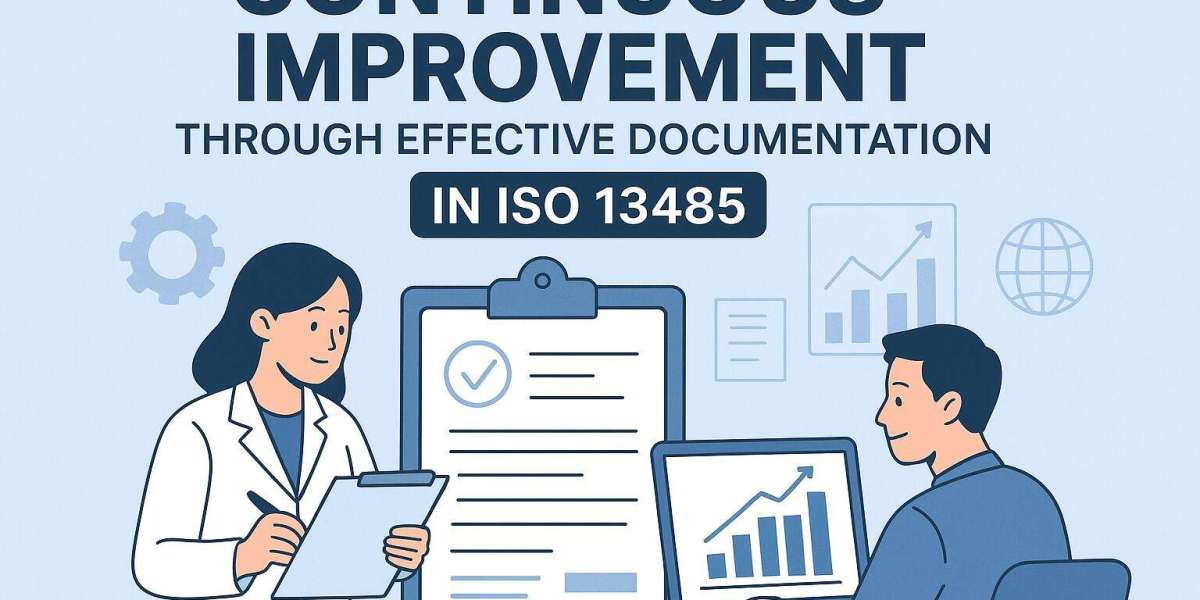In the medical device industry, quality management is not just a compliance requirement—it is a matter of patient safety and trust. ISO 13485, the internationally recognized standard for quality management systems (QMS) in medical device manufacturing, provides a structured framework to ensure consistent product quality, regulatory compliance, and risk management. Among its many elements, documentation plays a pivotal role in driving continuous improvement, which is the foundation of long-term success in highly regulated industries.
This article explores how effective documentation under ISO 13485 contributes to continuous improvement and why organizations should treat documentation as a strategic tool, not just a regulatory burden.
The Role of Documentation in ISO 13485
ISO 13485 requires organizations to establish, implement, and maintain documented processes that demonstrate compliance with regulatory and customer requirements. These documents include the quality manual, standard operating procedures (SOPs), work instructions, records, risk management files, and design and development documentation.
While documentation ensures that processes are standardized and repeatable, its true value emerges when it is used as a feedback mechanism to identify gaps, drive corrective actions, and prevent future nonconformities. This continuous cycle of planning, documenting, executing, reviewing, and improving lies at the heart of ISO 13485.
How Documentation Drives Continuous Improvement
- Standardization of Processes
Clear documentation ensures that every employee follows the same steps for critical processes such as design control, production, sterilization, and complaint handling. When processes are standardized, deviations become easier to detect. These deviations provide insights into areas needing improvement.
- Objective Evidence for Analysis
ISO 13485 requires organizations to maintain records as evidence of compliance. These records—such as inspection results, audit findings, and CAPA reports—become valuable data sources. By analysing these documented records, organizations can identify recurring issues, root causes, and trends that require corrective or preventive actions.
- Corrective and Preventive Actions (CAPA)
CAPA is a cornerstone of ISO 13485 DocumentationToolkit . Effective CAPA depends on thorough documentation. When nonconformities occur, detailed documentation of the problem, investigation, and corrective measures allows organizations to learn from mistakes and prevent recurrence. This systematic learning process is a direct driver of continuous improvement.
- Facilitating Risk Management
Risk management under ISO 14971 is closely linked with ISO 13485. Properly documented risk assessments, mitigation strategies, and monitoring activities ensure that risks are continuously evaluated. By updating and reviewing risk-related documents, organizations can enhance product safety and refine processes over time.
- Employee Training and Competence
Well-documented procedures provide a foundation for training. Employees who understand the procedures are less likely to make errors, and when they do, the documentation helps identify gaps in training. Updated training records, in turn, contribute to a cycle of skill improvement and process refinement.
- Supporting Internal and External Audits
Internal audits rely heavily on documented evidence to evaluate compliance and performance. Similarly, external auditors, whether from certification bodies or regulatory agencies, assess the effectiveness of an organization’s QMS by reviewing documents. Audit findings highlight opportunities for improvement, which, when addressed, push the organization toward higher levels of maturity.
Best Practices for Effective Documentation in ISO 13485
- Implement a Document Control System
Document control ensures that only the latest approved versions of documents are available to employees. An automated system with version tracking, access control, and change history makes documentation more reliable and easier to manage.
- Encourage Employee Involvement
Employees at all levels should have access to relevant documents and be encouraged to suggest improvements. A culture where feedback is documented and acted upon fosters continuous improvement.
- Integrate Risk-Based Thinking
Each document—whether it is a SOP or a design file—should reflect risk-based thinking. By documenting risks and mitigation measures at every stage, organizations can proactively improve processes instead of waiting for issues to occur.
- Link Documentation to Performance Metrics
Documents should not exist in isolation. Link them to measurable key performance indicators (KPIs). For example, a documented CAPA process should show reductions in repeat nonconformities, while training records should correlate with fewer operator errors.
- Review and Update Regularly
Continuous improvement requires living documents. Outdated procedures create inefficiencies and compliance risks. Organizations should establish regular review cycles to update documents in line with process changes, technological advancements, and regulatory updates.
The Strategic Value of Documentation
For many organizations, documentation is often viewed as a compliance exercise. However, when approached strategically, it becomes a powerful tool for organizational learning and improvement. Every documented audit finding, complaint investigation, or training session contributes to a knowledge base that strengthens the QMS. Over time, this creates a culture of improvement where lessons learned are captured, shared, and applied.
Furthermore, effective documentation builds confidence with regulators, certification bodies, and customers. It demonstrates that the organization not only complies with ISO 13485 but also actively uses the system to improve quality, reduce risks, and deliver safer medical devices.
Conclusion
Continuous improvement is not a one-time project but an ongoing commitment, especially in industries where patient safety is paramount. ISO 13485 documentation provides the foundation for this journey. When managed effectively, documents do more than demonstrate compliance—they enable organizations to identify gaps, track performance, prevent errors, and build a resilient quality management system.



